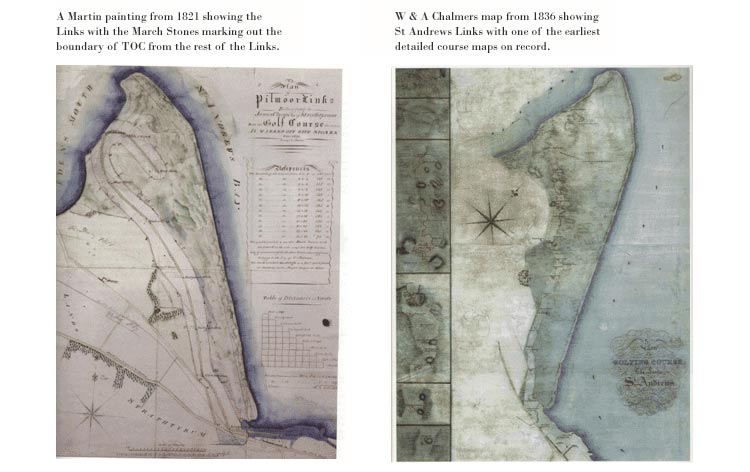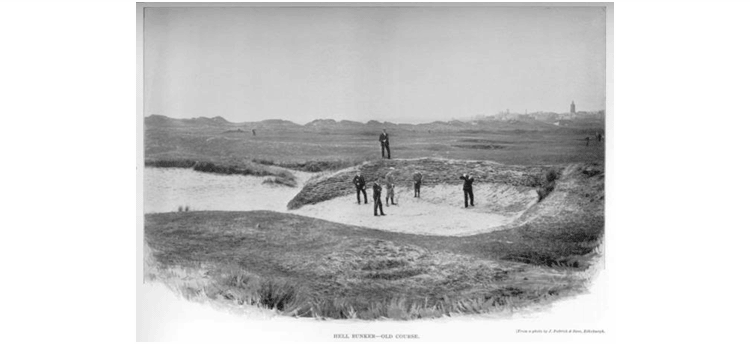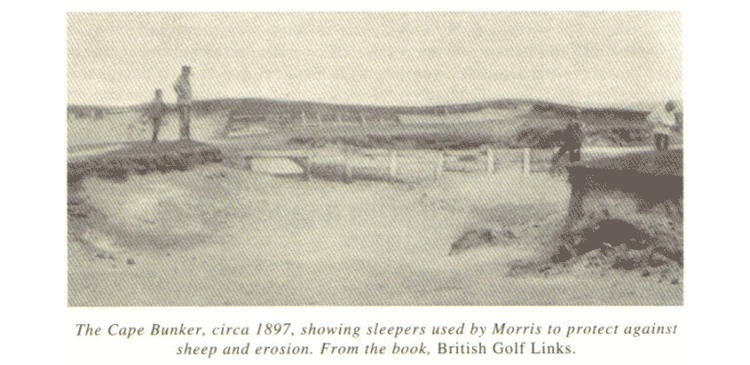From his return to St. Andrews in 1865 until his death in 1908, what were several of the primary things that he did to The Old Course from a design point of view?
If we are to talk about TOC then let’s look at the course pre Allan Robertson and Old Tom Morris. But before we do so Old Tom was approached by The R&A in 1864 to become the custodian of the course and in January 1865 the formal offer was made and accepted. Old Tom was back in St Andrews in 1865 to start the modifications to TOC.
On Old Tom’s return to St Andrews his first act was not to improve the course but to arrange for the building of the road across the fairways of the 1 & 18th Fairways. This has become known as Grannie Clark’s Wynd, being completed in 1866 to accommodate the public on their way to The West Sands.
However, the main underlying reason for the road was that the year before in 1865, a massive storm at sea had washed up huge amounts of seaweed onto the West Sands. Local farmers seeing a bonanza to that multitude quickly set to work clearing the seaweed from the sands before the next high tide reclaimed it. In doing so they used the seaward side of the 1st Fairway (before Old Tom modified the 1st & 18th) to store the seaweed. However in the process they did untold damage with their carts to the course, in dumping the seaweed on the 1st Fairway, and then in removing it to their farms with deep ruts left across the fairway by their wheels. Hence the need for a proper road. After the devastation, not just by the storm but also by the farmers carts (see carts again causing havoc on a golf course), the land now used as the 1st Fairway and Hole had to be repaired, and re-turfed. This was undertaken over approximately the next three years forming what we more or less see today in that the 1st Hole of TOC.
The course had become somewhat tired and a mess as described by a local newspaper of the time. Old Tom set about tidying up the course and, perhaps what may surprise some Architects and no doubt Green Keepers, he re-seeded the area between the Burn and the site of Halket’s Bunker.
We must credit Old Tom with repairing divots with sand from the West Sands. Every winter small mounds of sand would appear on the course ready for repairing the course and activating the turf into regeneration. The whole course underwent a massive face lift, or to be a little more precise, I think, a re-design would be more appropriate. As mentioned not only was the 1st Hole remodeled along with the building of the road to the beach, but the Swilken Burn was also banked and confined which in the end allowed for the siting of the new 1st Green.
The Swilken Burn & Bridge Water Colour 1870
Yet all this work would not have proceeded without reclaiming the land from the North Sea. This was originally started by Playfair, then Old Tom and Bruce finally completed the embankment. Without this work we would not have much of the 1st let alone, the 18th Holes left to play upon.
It’s very difficult to state which was Old Tom’s major works on TOC, because nearly everything is interlinked. Certainly the 1st & 18th Holes make the course open and attractive allowing more numbers on to the course. A massive amount of whins clearing, a major project requiring more or less the removal covering between the 2nd Tee through to the 7th & 11th Fairways. Nevertheless, that act of clearance allowed the course to be re-designed and extended, Greens modified and rebuilt, with some totally re-designed (7th, 6th & 12th) and Fairways widened thus a new larger course was born out of the old. I suppose it also opened out the course to be played clock and anti-clock wise. Yet through all this Old Tom had a battle on his hand with the ever threatening Eden Estuary. After every storm he wondered if the High Holes would still be there and would the shared Green of the 7th & 11th still exist.
TOC underwent an expansion; in fact it nearly doubled in size between the 1860-1875. If in any doubt the March stones (originally around 26 stones) that I previously mentioned, were laid out as TOC boundary in 1821. Some have survived and can be found not on the boundary but in the middle of the Fairways for the 4th, 5th & 7th. Then we have the work undertaken regards the bunkers, many were found to have water at the bottom as much as a foot to a foot and a half.
Old Tom set about filling in the bunkers to resolve the water table problem. He also set out new bunkers and, if we look closely, we see that sod wall (revetted) face of bunkers was not just confined to the 20th/21st Century, but actively use under Old Tom in the 19th Century. My understanding as to why only the face was originally revetted relates to golfers tendency of exiting the bunkers over the front, causing damage to the front edge. Looking at the 1897 photo of Hell Bunker we see that only the front has sods, while the remaining sides are left in a more natural state.
The Hell Bunker photo from the book British Golf Links 1897 with front sod wall.
Old Tom was an active user of old rail sleepers to form the walls of his bigger bunkers as illustrated by the photo below depicting The Cape Bunker.
The removing of the whins and combating the sea as well as continuing the reclaiming policy allowed Old Tom to re-design TOC into what it is today. IMHO a great course that many seem so happy to play and play and play. One thing that I am indeed proud of was his ability to understand the game and the way it clearly interfaced with the land and environment, something I feel was quickly lost by the Second World War. Such vital lessons that the land must be fit or sustainable for the game of golf otherwise do not build a course, still are being ignored in the mad belief that money allows the ability to build great golf courses. Alas, without large amounts of water these modern courses would soon revert to their natural state and would for the most part be unplayable.










